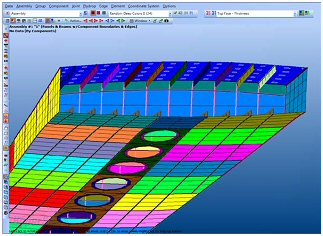
The latest version of the Hypersizer software includes new modelling capabilities for airframe wing box designs, and laminate zone and ply-count optimisation enhancements to improve manufacturing efficiency.
“Composites are booming due to stepped-up fuel consumption efficiency goals,” says Craig Collier, president of Collier Research, Hampton, Virginia, USA.
“This is pushing the movement towards lightweighting. But creation of lighter, stronger designs is limited by many of today’s standard industry practices. Weight is needlessly added because engineers have only a partial view of options. They often overdesign to play it safe.”
To overcome such drawbacks, HyperSizer targets weight while serving as an independent and neutral data exchange hub for CAD, FEA and composite software packages. It iterates with FEA solvers, calculates margins of safety, validates failure predictions with test data, and sequences composite laminates for fabrication – avoiding weight growth as designs mature.
“HyperSizer works from preliminary design through flight certification,” explains Collier.
“This gives the engineering team a more wide-open conceptual design space for performing trade studies involving thousands of alternatives. They can find robust solutions that lead to significant weight and cost savings. On average our customers reduce weight by 20%.”
| In the past, our designs were often overweight. HyperSizer has enabled our Centre to be more competitive in this regard. It’s a robust analysis tool that allows us to complete our weight and strength studies in far less time, while finding optimal ply coverages. |
| Ian Fernandez, former materials and analysis lead on NASA Ames Research Centre’s LADEE satellite project |
HyperSizer has been used on a variety of NASA spacecraft projects, including the current Space Launch System (SLS) rocket, previous Ares I and V launch vehicles, the Composite Crew Module, and the metal Orion Multi-Purpose Crew Vehicle. Commercial aviation customers include Boeing, Bombardier, Goodrich, Gulfstream and Lockheed Martin.
HyperSizer’s capabilities are also appropriate for applications in wind turbine blades, ship hull and superstructures, high-speed railcars, and automotive body components.
Hypersizer v6.2
New features in HyperSizer v6.2 include:
- discrete stiffener modeling – for airframe wing box and fuselage structures, the software automatically identifies in the FEM, skin shell and stiffener beam elements and optimises their spacings, heights, and laminates. This provides the flexibility for designing panel bays with non-uniformly spaced stiffeners of varying directions, dimensions, and materials, while also assigning margins to each unique stiffener panel segment.
- laminate optimisation for manufacturability – an improved, six-step process optimises laminates (transition zones, ply-count compatibility, ply drops/adds, global ply tracking) while balancing strength, stability, and manufacturability. This leads to fabrication efficiencies and factory-floor cost-savings.
- other enhancements – puck composite failure analysis for both 2D and 3D fibre fracture; curved (skin) local buckling analysis; upgraded compression and shear postbuckling analyses; enhanced panel concepts (PRSEUS, reinforced core sandwich, and tapered tube beam); improved test data and other graphical displays and functions; and new methods documentation.





